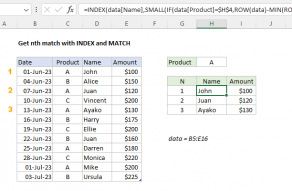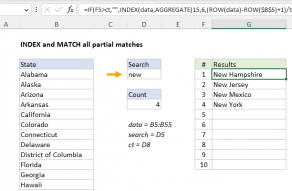Explanation
Note: in more recent versions of Excel, the FILTER function is a better way to solve this problem. The INDEX and MATCH formula explained here is meant for legacy versions of Excel that do not provide the FILTER function.
By default, lookup formulas in Excel like VLOOKUP and INDEX + MATCH will find the first match, but not other matches that may exist in a set of data. However, with some effort, you can make INDEX and MATCH return all matches. One way to approach this problem is to use a helper column to return a numeric value that indicates a match. This makes it much easier to identify and extract multiple matches.
Helper column
A helper column is a way to simplify a complex formula in Excel by breaking the problem down into smaller steps. In the worksheet shown, a helper column is used to identify matching data based on conditions entered in the range I3:J3. The formula in the helper column in cell E3 looks like this:
=SUM(E2,AND(C3=$I$3,D3=$J$3))
The helper column tests each row in the data to see if the Department in column C matches the value in I3 and the Building in column D matches the value in J3. Both logical tests must return TRUE in order for AND to return TRUE.
For each row, the result from the AND function is added to the "value above" in the helper column to generate a count. The practical effect of this formula is an incrementing counter that only changes when a (new) match is found. Then the value remains the same until the next match is found. This works because the TRUE/FALSE results return by AND are coerced to 1/0 values as part of the sum operation. FALSE results add nothing and TRUE results add 1.
Back in the extraction area, the lookup formula for Name in column H looks like this:
=IF($G6<=ct,INDEX(data,MATCH($G6,helper,0),1),"")
Working from the inside out, the INDEX + MATCH part of the formula looks up the name for the first match found, using the row number in column G as the match value:
INDEX(data,MATCH($G6,helper,0),1)
INDEX receives all 3 columns of data as the array (named range "data"), and MATCH is configured to match the row number inside the helper column (the named range "helper") in exact match mode (3rd argument set to zero).
This is where the cleverness of the formula becomes apparent. The helper column obviously contains duplicates, but it doesn't matter, because MATCH will match only the first value. By design, each "first value" corresponds to the correct row in the data table.
The formulas in columns I and J are the same as H, except for the column number, which is increased in each case by one.
The IF statement that wraps the INDEX/MATCH formula performs a simple function — it checks each row number in the extraction area to see if the row number is less than or equal to the value in G3 (named range "ct"), which is the total count of all matching records. If so, the INDEX/MATCH logic is run. If not, IF outputs an empty string ("").
The formula in G3 (named range "ct") is simple:
=MAX(helper)
Since the maximum value in the helper column is the same as the total match count, the MAX function is all we need.
Note: the extraction area needs to be manually configured to handle as much data as needed (i.e. 5 rows, 10 rows, 20 rows, etc.). In this example, it is limited to 5 rows only to keep the worksheet compact.
I learned this technique in Mike Girvin's book Control + Shift + Enter.
The FILTER function
If you have a current version of Excel, the FILTER function is a better way to extract all matching records.















